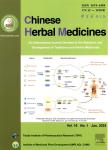Neuroprotection of n-Butanol Extract from Roots of Potentilla anserina on Hypoxic Injury in Primary Hippocampal Neurons
Neuroprotection of n-Butanol Extract from Roots of Potentilla anserina on Hypoxic Injury in Primary Hippocampal Neurons作者机构:Department of PathologyAffiliated Hospital of Logistic University of Chinese People's Armed Police ForcesTianjin 300162China Department of Medicinal ChemistryLogistic University of Chinese People's Armed Police ForcesTianjin 300162China Tianjin Key Laboratory of Occupational and Environmental Hazard BiomarkersTianjin 300162China Tianjin Key Laboratory of Occupational and Environmental Hazard BiomarkersTianjin 300162China Logistic University of Chinese People's Armed Police ForcesTianjin 300162China
出 版 物:《Chinese Herbal Medicines》 (中草药(英文版))
年 卷 期:2012年第4卷第3期
页 面:195-200页
学科分类:1008[医学-中药学(可授医学、理学学位)] 1006[医学-中西医结合] 100602[医学-中西医结合临床] 10[医学]
基 金:Natural Science Foundation of China (30672774 81073152) the Great Program of Science Foundation of Tianjin (10JCZDJC21100)
主 题:hypoxia mitochondria neuron Potentilla anserina ultra-microstructure
摘 要:Objective To investigate the protective effect of n-butanol extract from the roots of Potentilla anserina (NP) on hypoxic hippocampal neurons in neonatal rats. Methods Primary cultured hippocampal neurons were pretreated with different concentration of NP (0.25, 0.0625, and 0.0156 mg/mL) before incubation in a low oxygen (0.1%) environment for 4 h. Cell viability was evaluated by Trypan blue staining assay. Lactate dehydrogenase (LDH) released by neurons into the medium was measured. The activity of superoxide dismutase (SOD) in cell cytosol was determined using nitroblue tetrazolium. Morphological changes and mitochondrial function were observed by transmission electron microscopy. Results Hypoxic injury could decrease the cells viability of neuron, enhance LDH release (P 0.05), decrease SOD activity, and increase mitochondrial injury. Pretreatment with NP significantly increased cell viability, decreased LDH release (P 0.05), promoted SOD activity (P 0.05), and remarkably improved cellular ultra-microstructure compared with the model group. Conclusion NP could protect the primary hippocampal neurons from hypoxic injury by attenuating mitochondrial cell death.



